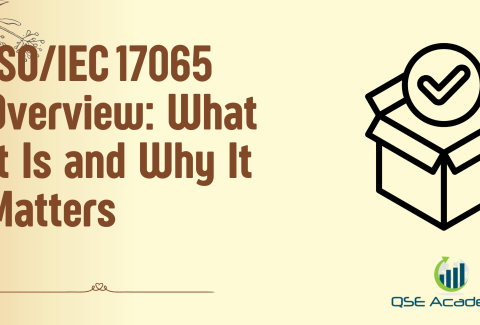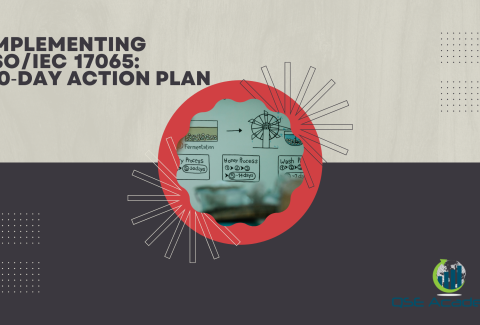ISO/IEC 17065:1996 vs ISO/IEC 17065:2012 – Changes at a Glance
Understanding What Changed and Why It Matters
Here’s what I’ve noticed over the years helping certification bodies transition from older versions of standards: most teams underestimate how different 2012 actually is compared to the 1996 era. On paper it looks like a revision, but in practice it reshapes how certification bodies operate, document decisions, and demonstrate impartiality.
The biggest challenge readers face is separating “cosmetic updates” from the changes that genuinely impact accreditation. That’s why this guide exists—to give you a clean, straightforward view of the real shifts, not just the wording differences.
By the end, you’ll understand the structural redesign, the elevated expectations on impartiality, the addition of risk reasoning, and the new clarity around communication, complaints, and decision-making. More importantly, you’ll see how these changes translate into daily operations.
Major Structural Changes in ISO/IEC 17065:2012 (Framework Evolution & Clause Reorganization)
Here’s what stands out immediately: 2012 isn’t just a rewrite—it’s a complete structural overhaul to align with modern CASCO frameworks. The clauses finally flow logically from structural requirements to management system controls, instead of the scattered layout in the 1996 version.
I’ve seen certification bodies run into trouble simply because they didn’t update their documentation layout. Their internal procedures still referenced old clause numbers, creating confusion during audits. One assessor told me, “Your system is compliant, but your references make it look like it isn’t.”
What you should do:
- Map each old clause to its new equivalent.
- Refresh all internal documentation titles, clause references, and flowcharts.
- Train staff on the new structure to avoid mixed interpretations.
Pro Tip: Create a crosswalk matrix with three columns: old clause → new clause → evidence. It keeps audits clean and traceable.
Avoid This Mistake: Assuming a structural change doesn’t require procedural updates. It does.
 Strengthened Impartiality Requirements (Independence, Conflict-of-Interest Controls, Risk Review)
Strengthened Impartiality Requirements (Independence, Conflict-of-Interest Controls, Risk Review)
In my experience, impartiality is one of the areas where certification bodies get surprised. The 2012 version digs deeper. It expands definitions, clarifies expectations, and forces CBs to look at impartiality risks across every stage—not just at decision-making.
The biggest shift? You’re now expected to use a structured, evidence-driven approach to manage impartiality risks. That includes documenting financial pressures, subcontracting relationships, consultancy overlap, and even personal conflicts.
I once worked with a CB that assumed their independence was “obvious” because of their structure. But when the accreditation body asked for impartiality risk evidence specific to evaluation and decision functions, they had nothing documented. They scrambled, and it cost them months.
What you should do:
- Maintain an impartiality committee with defined responsibilities.
- Document risk assessments annually (or more often if needed).
- Evaluate subcontractors through the impartiality lens too.
Common Pitfall: Treating impartiality as static. It’s dynamic, especially in growing CBs.
Introduction of Risk-Based Thinking (Risk Justification, Decision Integrity, Scheme Controls)
Risk-based thinking didn’t exist in the old version at the level it exists now. The 2012 edition expects you to justify decisions using a risk perspective. It ties risk to impartiality, evaluation, sampling methods, surveillance activities, and even how you communicate certification rules.
Here’s the key difference: decisions must now be defensible, consistent, and traceable. If an evaluator recommends certification based on limited evidence, the decision-maker must understand the risk impact—not just tick a box.
A client I helped had excellent technical processes but struggled to articulate risk rationales. They relied on “expert judgement,” which sounds good but provides zero traceability during audits. Once they built a simple risk matrix linked to their scheme requirements, everything changed—reviews became faster, clearer, and more robust.
What you should do:
- Maintain a risk register tied to scheme rules.
- Link risk assessments directly to decision documentation.
- Train reviewers to report risk explicitly.
Avoid This Trap: Borrowing risk descriptions from ISO 9001. Context is different.
Expanded Requirements for Certification Processes (Evaluation, Review, Decision, and Surveillance)
The 2012 revision breaks down the certification process into clearly separated activities. Evaluation, review, and decision now have distinct responsibilities and competence requirements.
This separation is more than administrative. It safeguards impartiality and ensures that decisions come from independent review rather than evaluator influence.
I’ve seen CBs lose audit points because their evaluators also performed the final decision review “in exceptional cases.” Accreditation bodies don’t accept that anymore. The standard is blunt: independence is mandatory.
What you should do:
- Define each process and assign roles clearly.
- Train decision-makers separately from evaluators.
- Build process maps reflecting the updated structure.
Pro Tip: Use a swimlane diagram to show evaluator → reviewer → decision-maker. Simple, powerful, auditable.
Common Mistake: Letting technical experts influence certification decisions without a separate independent review.
Revised Documentation & Record-Keeping Requirements (Documented Procedures, Traceability, Evidence Control)
Documentation has become stricter and more explicit. ISO/IEC 17065:2012 demands clear traceability for every step—from evaluation to decision. You’re expected to retain records that prove competence, sampling methods, subcontractor evaluations, and complaint resolutions.
Here’s what I’ve noticed: CBs often forget to update their terminology. Their procedures still say “Guide 65” or use outdated definitions, which signals an incomplete transition to assessors.
What you should do:
- Update terminology, definitions, and references.
- Use centralized document control with versioning.
- Ensure records support risk reasoning and impartiality logic.
Pro Tip: Keep decision rationales short but specific. Assessors care about clarity, not volume.
Avoid This Mistake: Using archived templates without updating them to match 2012 requirements.
Stronger Customer Interaction & Transparency Requirements (Public Information, Appeals, Communication Clarity)
The 2012 edition pushes for transparency. Certification bodies must share clear rules, evaluation methods, appeals processes, and complaints procedures. It also distinguishes between appeals (internal) and complaints (external), which was vague in the 1996 version.
A CB I worked with received a non-conformity because they published outdated rules on their website. Their internal documents were correct, but the public-facing information wasn’t updated. Simple oversight, big impact.
What you should do:
- Publish up-to-date certification rules.
- Maintain clear descriptions of your evaluation and decision processes.
- Track complaints and appeals separately.
Pro Tip: Assign a single person responsible for public information updates. It avoids version control problems.
Alignment with ISO/CASCO Framework and Integration with Related Standards (Harmonization, Multi-Standard System Compatibility)
The 2012 revision aligns ISO/IEC 17065 with the broader ISO/CASCO suite. That means easier integration with ISO/IEC 17021-1, ISO/IEC 17020, and ISO/IEC 17025.
This is important because many certification bodies operate across multiple conformity assessment standards. Harmonization reduces duplication and streamlines internal systems.
I’ve seen CBs benefit massively when they use shared processes for document control, impartiality management, and complaint handling across different standards.
What you should do:
- Cross-reference common processes (complaints, impartiality, training).
- Use shared documentation where possible.
- Align management system options A or B with ISO 9001 if it helps your structure.
Common Pitfall: Keeping siloed systems for each standard—it’s unnecessary now.
FAQs
Why did ISO replace the 1996 version with the 2012 revision?
The conformity assessment world evolved. CASCO wanted consistency, stronger risk controls, clearer independence, and improved transparency.
Do certification bodies need a full rewrite of their system?
Not necessarily. But you do need structural alignment, updated definitions, revised procedures, and clearer impartiality evidence.
How long does transitioning typically take?
In my experience, 2–6 months is realistic depending on system maturity and how much documentation you need to update.
Conclusion — Your Next Step Toard Full Compliance
The transition from ISO/IEC 17065:1996 to ISO/IEC 17065:2012 isn’t just a technical alignment—it’s a mindset shift. You now operate with clearer structure, stronger impartiality, better risk justification, and more transparent communication.
This is where experience matters. I’ve helped certification bodies navigate these updates, rewrite their procedures, and prepare for smooth accreditation audits. You can absolutely do this with the right guidance and a structured approach.
If you want a faster transition, start with a detailed crosswalk matrix and a documentation update checklist.
And if you need help reviewing your current system, I can walk you through it step-by-step.
Melissa Lavaro is a seasoned ISO consultant and an enthusiastic advocate for quality management standards. With a rich experience in conducting audits and providing consultancy services, Melissa specializes in helping organizations implement and adapt to ISO standards. Her passion for quality management is evident in her hands-on approach and deep understanding of the regulatory frameworks. Melissa’s expertise and energetic commitment make her a sought-after consultant, dedicated to elevating organizational compliance and performance through practical, insightful guidance.









